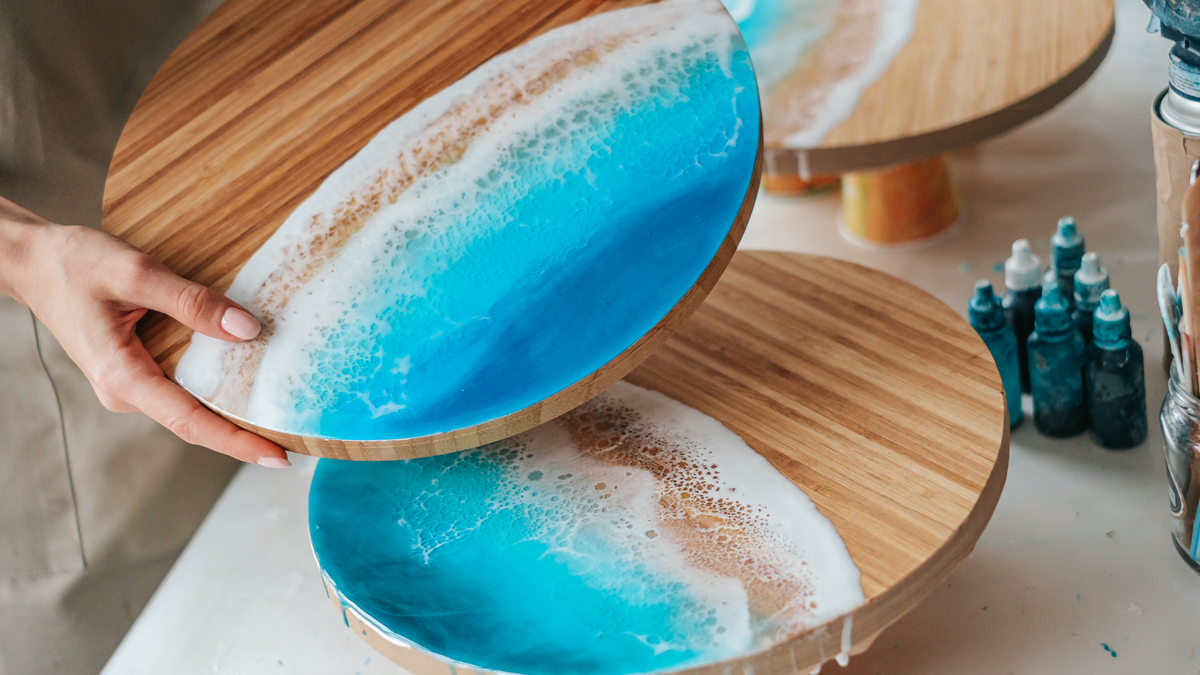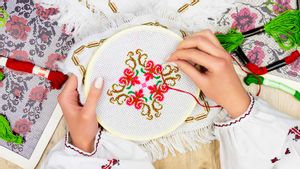Whether you are a newbie in this space or a seasoned artist, resin art is a super fun and creative medium to explore the hidden artist inside you.
This art form is a unique type of painting form where there is no use of any typical brushes, oil paints or acrylic. It is an art form that uses moulds, and is not challenging to pick up. It also supplements various areas like installation arts, furniture designs and paintings.
If you are someone who has always had a keen interest in learning a new art form, we suggest you get your hands creative with resin art. Let’s jump straight into what this is, shall we?
What is resin art?
Resin art is a unique style of painting where there is no use of typical brushes, oil paints or acrylic. Simply speaking, resin art is created by combining some resin and some hardener for aesthetic purposes. This mixed solution of resin and hardener is poured into a mould and allowed to dry for some time. The mould is later opened. The casting is then extracted, leaving a positive impression on the inside part of the mould. Resin art is an art form that lasts a lifetime and makes for the perfect gift which you can give to your friends or family, especially because you can customise this art as per the choices of your loved ones.
A popular type of resin art is the Geode Resin Art. This is made by placing crushed glass and crystals along with the tinted resin in order to recreate a art form that resembles natural rock formations.
The different types of resin
Most of the resins that are available comprise two components, the hardener (that acts as a catalyst) and the base resin. When you mix both of these components together, a chemical reaction occurs that causes the resin to set. So, there are two types of epoxy resin that can be used:
Deep pour resin

A deep pour resin is the resin you want to use when you need to fill a larger or deeper space with epoxy resin. The deep pour resin is formulated for this particular purpose only. The texture is thin so that one can pour more into a given space while not becoming very dense at the same time. This type of resin is well suited for tabletop pouring, wooden wall art, resin box art, jewellry, coasters and other applications where resin is used in deep or larger spaces. Curating art with this type of resin looks easy, but if it's not been done before, it may become challenging, especially when it is being poured on tabletops. The hack lies in the correct consistency and right mixing ratios in such large volumes, and then factoring in the colours and effect you’d like to see once the resin has set and cured completely, which can be rather challenging.
Surface pour resin
Surface pour resin is comparatively thicker as compared to deep pour resin. This is thicker because only a finite amount of resin is required and is spread over a surface of a piece being created. Surface pour resin dries up faster than deep pour resin.
Making resin art for beginners
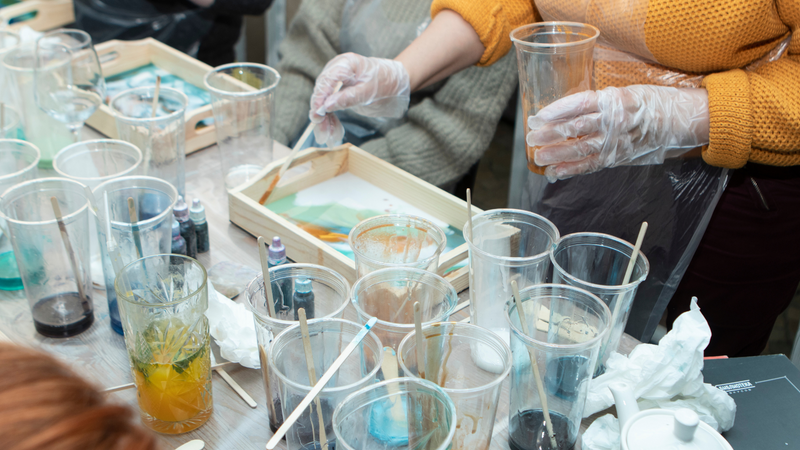
Follow these steps to make epoxy resin art for beginners:
1. Prepare your canvas: Any standard of canvas can be used as per your choice. However, we recommend that you choose a wooden canvas that is made of hardwood, pine or birch.
2. Disposable plastic cups: Disposable plastic cups are used for mixing the resin and for storing it during the process of painting. If you want to avoid using plastic cups, you can choose any other palate that is used during the normal painting process. Our recommendation is to use reusable silicon cups.
3. Plastic covering: Protect your painting space and other spaces from resin by covering them with a plastic sheet or any other form of protection.
4. Gloves: Resin is extremely sticky and does not come off your hands easily. Hence, wearing gloves is a must, especially because you use your hands to move the resin around while you’re painting.
5. Safety equipment: Remember that every category of resin has different safety guidelines, so make sure to check with that brand while you are using the same. We recommend that you wear your safety glasses and a respirator which is custom-designed only for resin.
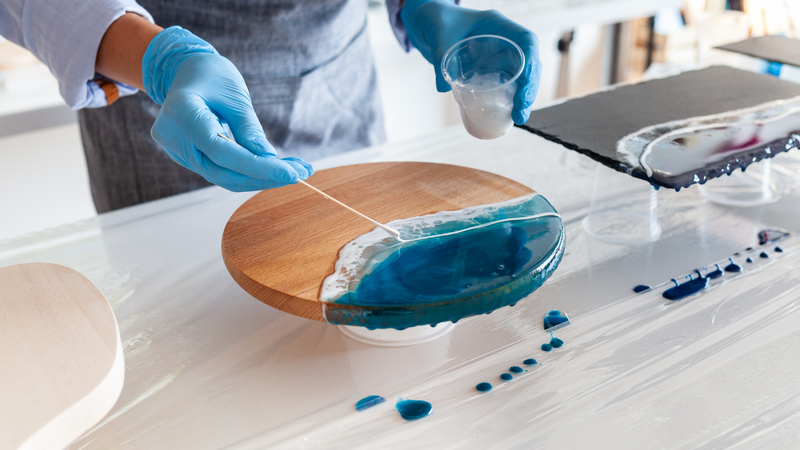
6. Mixing: We recommend you to use popsicle sticks in order to mix the resin and colours. Please keep in mind that it’s imperative to follow the instructions mentioned on the bottle carefully. It's recommended that you do not mix too much resin at once because resin tends to harden quickly, and once you have mixed it, it can only be used for approximately 30 minutes.
7. Colouring: Purchase inks and colours that are specifically designed only for resin. As these are custom-designed resin pigments, they might be heavy on your pocket. But if you are just a beginner, we suggest that you invest in high-quality white ink and comparatively cheaper quality colours while you are in the learning process. Remember, resin can be dyed with paint, ink, metallic powders, pigments or even household items, like paprika or turmeric (haldi). You can even add silicone oil to the colour mixture.
8. Pouring: You can now start pouring the resin cups individually on your painting canvas or use any of the pouring techniques namely Air Swipe, Swirl, Dirty Pour, Puddle Pour, Flip Cup, etc. You can experiment further by influencing the resin course on your painting canvas with a spatula, brush, foam roller, knife, silicone brush etc. or by tilting the painting canvas. However, avoid air bubbles in your painting. In case of any, you can remove them by using a hot air blow-dryer. Further, in order to avoid the presence of any foreign particles like mosquitoes, dust or anything else on the painting, remove the same with the help of tweezers.
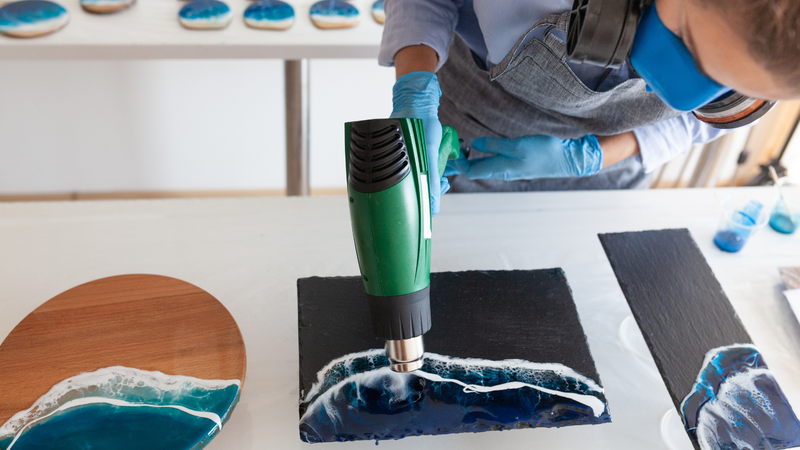
9. Drying: If the casting resin starts drying after some time, the painting should not be changed, because the resin becomes very viscous and feels like chewing gum with threads pulling out. It loses the most important property of self-levelling.
When the painting is completely finished and is free of air bubbles or foreign particles, you should use cardboard to protect it from dust. Place this cardboard plate on four bottles. A resin piece is completely cured only after three full days and should not be exposed to high-temperature fluctuations in its drying time. In case you want to apply more resin layers, do it after the resin has dried (five hours).
What is epoxy resin?
Epoxy resins are basically a two-component system. It consists of resin and a hardener. When you mix these two components, a chemical reaction takes place which helps the liquid resin harden to a solid plastic within a few hours. This process gives a glossy and clear surface.
Colours and dyes suitable for resin art
There are different types of colours or dyes that are available to give a tint to epoxy resin. Some popular resin colours include powdered pigment, mica powder, richly saturated resin tint, alcohol ink, acrylic paint, acrylic ink and glitter. These colours are available in many other types of options like solid colours, metallic colours, neon, fluorescents, and pearlescent.
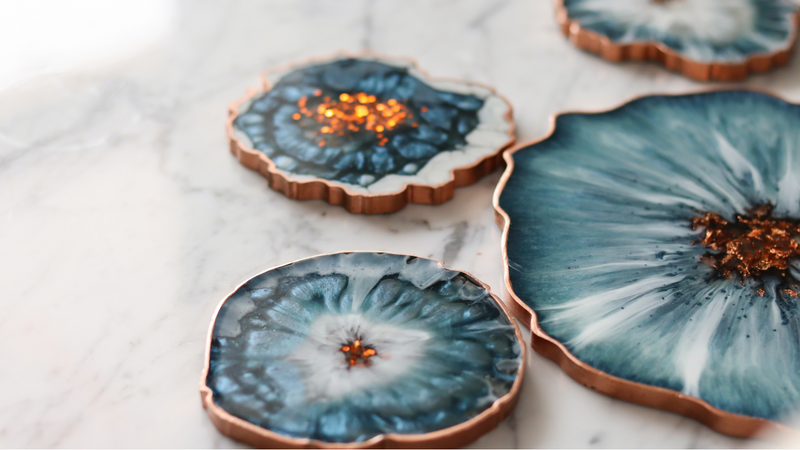
FAQs
1. Is resin art expensive?
Yes, it is expensive as epoxy resin is costly and hence creating an epoxy resin art is too.
2. Is resin art easy to make?
Resin art is easy to start off as a hobby, because it does not require any specific training. It's a great handicraft to create on your own at home. However if you want to pursue resin art seriously, you need to develop a meticulous level of skill, practice and proficiency for the same.


